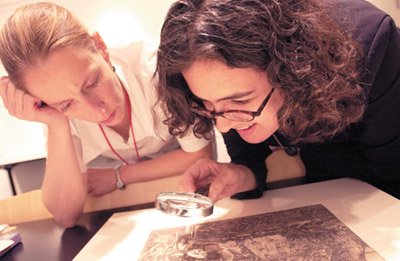 Chicago
Journal
Chicago
Journal
A Smart exhibit is born
Two
years before the Smart hangs one of its Mellon Project shows, the brainstorming
begins.
Elizabeth Rodini, PhD'95, curator
of Mellon Projects at the David and Alfred Smart Museum of Art, isn't above having
a good laugh at ugly artwork. Neither is Rebecca Zorach, AM'94, PhD'99, a Collegiate
assistant professor in humanities who is co-curating a Mellon Project to be exhibited
in autumn 2004.
|
Worth
the wall space? Curators Elizabeth Rodini (left) and Rebecca Zorach debate including
a Dürer print in an upcoming show.
Photograph
by Dan Dry |
"Ewwww!"
"Aren't
those noses awful?"
Standing above a box
of prints one afternoon this summer, the pair giggle like high-school girls. They
aren't being art snobs-in fact, the noses on the angelic host surrounding an unnamed
pope in this particular print are awful, potato-shaped things. It's just that,
after two hours in the understated lighting and quiet air of the museum's Kanter
Educational Study Room, looking at centuries-old pieces of parchment paper bearing
mechanical reproductions of paintings and frescoes, Rodini and Zorach have gotten
a bit punchy.
"OK, we're wasting time,"
Rodini sighs and returns box No. 119, Italian, to the storage room, where she
retrieves box No. 116, English. Punchiness, Rodini notes apologetically, comes
with the territory of exhibition planning, especially in the early stages when
a curator is still narrowing down the topics to cover within a broad theme, long
before deciding exactly what will be in the show.
The
purpose of this exhibition, which for now Zorach is calling The Reproductive
Print in Early Modern Europe, is to examine the functions of printmaking in
Europe's first age of mechanical reproduction, about 1500- 1850. As printmaking
technology developed in the 16th century, prints were used to record and reproduce
paintings and other works of art, such as frescoes, sculptures, and antiquities.
And for the first time, widespread audiences could "vicariously enjoy"
images. Mechanical printmaking also was an inexpensive way for artists to advertise
their works-and for plagiarists to copy them.
Early
in 2003 Zorach will gather a small group of advanced art-history graduate students
whose own studies focus on printmaking. They'll research an initial selection
of 50-60 prints, narrowing that down to 30-40, and help Zorach research and write
a scholarly catalog to be published by the University of Chicago Press.
With
so many possibilities in the Smart's print collection-and relatively sparse background
information on them-the difficult part, Zorach says, "is deciding when we
have a productive line of research for a graduate student." Today she and
Rodini are searching for trailheads: works that might fit the "vicarious
enjoyment" theme and merit more legwork. It's the first time Zorach has curated
a show and also her first time thinking like a scout leader rather than one of
the troop: "It's an interesting mental shift."
If
Zorach is learning something, then the Mellon Projects must be working. The
Reproductive Print will be the ninth in an ongoing series of exhibitions funded
by several gifts from the Andrew W. Mellon Foundation since 1992. In each, the
Smart has collaborated with University faculty members-from art history to English
to Germanic studies-to create exhibitions around which courses or student projects
are designed. The projects give students practical experience in curating and
catalog writing-both résumé builders that art-history Ph.D.s, Rodini
notes, crave.
Zorach was initially inspired to
mount a Mellon Project by Marcantonio Raimondi's famed 16th-century engravings
after Raphael's paintings-as well as Raimondi's unauthorized copies of Dürer's
works. (Whether the Smart will borrow examples of these is still undecided.) Raimondi's
engravings and other early prints, Zorach says, brought forth "the issue
of authenticity" and sparked insecurities about intellectual property. "You
get so many people contributing to a project"-the painter or collector who
commissioned the print, the engraver, the printmaker, the print seller-"that
it's difficult to say where authorship ends and begins."
Looking
at The Crucifixion, after Tintoretto (1741), a 4-1/2-foot-wide earth-toned
tryptich of woodcut prints, Rodini comments, "These are a classic example
in some ways-and the format is so big. They have wall presence, which is something
to keep in mind. Lots of dinky prints can get exhausting."
"The
technique is interesting. And it adds color," Zorach agrees. The prints bear
a British-looking crest with the names John Baptist Jackson and Richard Boyle.
She pencils the call numbers into her notebook as Rodini wonders at engraver Jackson's
assignment from Boyle, the collector. "Did Boyle take Jackson on his Grand
Tour, to make a collection of the works he'd seen?"
Beyond
their subject matter and impact on the art world, Zorach is intrigued by the role
prints played in the larger society of early modern Europe. Printmaking, she notes
in her exhibition proposal, whetted the appetite for antiquity in northern Europe.
Did prints of religious subjects similarly incite worship? And did devotional
prints acquire higher status if they were reproductions of famous paintings?
Through
her Mellon Project, she hopes to find out.
- Sharla A. Stewart


![]() Contact
Contact
![]() About
the Magazine
About
the Magazine ![]() Alumni
Gateway
Alumni
Gateway ![]() Alumni
Directory
Alumni
Directory ![]() UChicago
UChicago![]() ©2002 The University
of Chicago® Magazine
©2002 The University
of Chicago® Magazine ![]() 5801 South Ellis Ave., Chicago, IL 60637
5801 South Ellis Ave., Chicago, IL 60637![]() fax: 773/702-0495
fax: 773/702-0495 ![]() uchicago-magazine@uchicago.edu
uchicago-magazine@uchicago.edu
